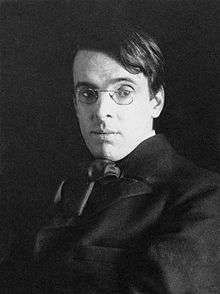Irische Legende
Irische Legende (Irish Legend) is a 1955 opera by Werner Egk who also wrote the libretto after the 1892/1899 verse drama The Countess Cathleen by W. B. Yeats. It premiered at the Salzburg Festival on 17 August 1955.
| Irische Legende | |
|---|---|
| Opera by Werner Egk | |
.jpg) The composer on a German stamp | |
| Librettist | Egk |
| Language | German |
| Based on | The Countess Cathleen by W. B. Yeats |
| Premiere | |
History

Irische Legende was the first opera that Egk composed after World War II.[1] He had studied with Carl Orff in Munich, and was successful in the 1930s with Die Zaubergeige, Peer Gynt and Columbus. He was invited to compose an opera for the 1955 Salzburg Festival. The project was supported by Wilhelm Furtwängler. Egk wrote his own libretto based on The Countess Cathleen by Yeats which has elements of Irish mysticism from both heathen and Christian roots.[2]
Irische Legende was premiered at the Salzburg Festival on 17 August 1955, conducted by George Szell and directed by Oscar Fritz Schuh, with Inge Borkh and the young Walter Berry in leading roles.[1][3] The premiere performance was broadcast by international radio stations.[2] The premiere received international recognition. The Salzburg Festival presented nine premieres between 1947 and 1957, including von Einem's Dantons Tod, Orff's Antigone, Blacher's Romeo und Julia and Die Liebe der Danae by Richard Strauss.[2] Egk revised the opera in 1975.[4]
Plot
Ireland suffers a famine. Two messengers of the devil, disguised as merchants, promise food to the hungry in return for selling their souls. Many despaired give in and end in hell. The countess Cathleen offers her soul to save the others. Egk explained that he liked the concept that one person could try, against all odds, to stand up for others in a seemingly hopeless situation ("dass ein Einzelner in scheinbar hoffnungsloser Lage – der eigenen Verantwortung bewusst und gegen alle Wahrscheinlichkeit – einen Ausbruch aus der Hoffnungslosigkeit unternimmt").[2]
Roles
| Role | Voice type | Premiere cast, 17 August 1955 Conductor: George Szell[3][5] |
|---|---|---|
| Cathleen | soprano | Inge Borkh |
| Der Dichter Aleel (Aleel, the poet) | baritone | Kurt Böhme |
| Die Amme Oona (Oona, the nurse) | contralto | Margarete Klose |
| Der Verwalter (The Admistrator) | baritone | Franz Bierbach |
| Zwei Hirten (two Shepherds) | tenor, bass | Waldemar Kmentt, Theo Baylé |
| Der Tiger (The Tiger) | baritone | Walter Berry |
| Zwei Eulen (two Owls) | soprano, contralto | Chloe Owen, Lilian Benningsen |
| Der Geier (The Vulture) | tenor | Laszlo Szemere |
| Die Schlange | dancer | Maria Litto |
| Zwei Hyänen in Gestalt von Kaufleuten (Two Hyenas in the appearance of merchants) | tenor, baritone | Max Lorenz, Oskar Czerwenka |
| Fausts Erscheinung (Apparition of Faust) | bass | Gottlob Frick |
| Stimme hinter der Szene (Satanas) (Voice behind the scene, Satan) | bass | Gottlob Frick |
| Seele (Soul) | Patricia Brinton | |
| Die leeren Seelen, Engel, Hirten, Knechte, Volk (The empty souls, angels, shepherds, servants, crowd | ||
The story takes place in Ireland in legendary time.
Recording
- Irische Legende Inge Borkh, Kurt Böhme, Walter Berry, Max Lorenz, Gottlob Frick, Waldemar Kmentt, chorus of the Wiener Staatsoper, Wiener Philharmoniker, George Szell[3]
References
- Ashley, Tim (17 August 2001). ""Eine kleine Nazi musik?"". The Guardian. Retrieved 15 June 2019.
- Hornig, Norbert (30 September 2001). "Werner Egk – "Irische Legende"". Deutschlandfunk. Retrieved 15 June 2019.
- "Irische Legende". Operone (in German). Archived from the original on 4 March 2016. Retrieved 15 June 2019.
- The Oxford Dictionary of Music 0199578540 ed. Michael Kennedy, Tim Rutherford-Johnson, Joyce Kennedy, 2013 p. 256: "operas: Columbus (1933 radio, 1942 stage); Die Zaubergeige (1935, rev. 1954); Peer Gynt (1938); Circe (1945, rev. 1966 as 17 Tage und 4 Minuten); Irische Legende (after Yeats, 1955, rev. 1970); Der Revisor (after Gogol's The Government Inspector, 1957); Die Verlobung in San Domingo (1963)."
- 17-08-1955 Almanacco
External links
- Irische Legende (in German) musirony.de